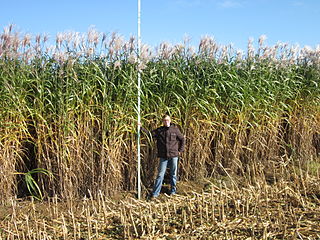
Cymbopogon, also known as lemongrass, barbed wire grass, silky heads, Cochin grass, Malabar grass, oily heads, citronella grass or fever grass, is a genus of Asian, African, Australian, and tropical island plants in the grass family. Some species are commonly cultivated as culinary and medicinal herbs because of their scent, resembling that of lemons . The name cymbopogon derives from the Greek words kymbe and pogon "which mean [that] in most species, the hairy spikelets project from boat-shaped spathes." Lemongrass and its oil are believed to possess therapeutic properties.

Citronella oil is an essential oil obtained from the leaves and stems of different species of Cymbopogon (lemongrass). The oil is used extensively as a source of perfumery chemicals such as citronellal, citronellol, and geraniol. These chemicals find extensive use in soap, candles and incense, perfumery, cosmetic, and flavouring industries throughout the world. Citronella oil is also a plant-based insect repellent and has been registered for this use in the United States since 1948. The United States Environmental Protection Agency considers oil of citronella as a biopesticide with a non-toxic mode of action.

Chrysopogon zizanioides, commonly known as vetiver and khus, is a perennial bunchgrass of the family Poaceae.

An insect repellent is a substance applied to the skin, clothing, or other surfaces to discourage insects from landing or climbing on that surface. Insect repellents help prevent and control the outbreak of insect-borne diseases such as malaria, Lyme disease, dengue fever, bubonic plague, river blindness, and West Nile fever. Pest animals commonly serving as vectors for disease include insects such as flea, fly, and mosquito; and ticks (arachnids).

Citronellal or rhodinal (C10H18O) is a monoterpenoid aldehyde, the main component in the mixture of terpenoid chemical compounds that give citronella oil its distinctive lemon scent.

Citral is an acyclic monoterpene aldehyde, and being a monoterpene, it is made of two isoprene units. Citral is a collective term which covers two geometric isomers that have their own separate names; the E-isomer is named geranial (trans-citral) or citral A. The Z-isomer is named neral (cis-citral) or citral B. These stereoisomers occur as a mixture, not necessarily racemic; e.g. in essential oil of Australian ginger, the neral to geranial ratio is 0.61.
The holy anointing oil formed an integral part of the ordination of the priesthood and the High Priest as well as in the consecration of the articles of the Tabernacle and subsequent temples in Jerusalem. The primary purpose of anointing with the holy anointing oil was to sanctify, to set the anointed person or object apart as qodesh, or "holy".

Digitaria is a genus of plants in the grass family native to tropical and warm temperate regions but can occur in tropical, subtropical, and cooler temperate regions as well. Common names include crabgrass, finger-grass, and fonio. They are slender monocotyledonous annual and perennial lawn, pasture, and forage plants; some are often considered lawn pests. Digitus is the Latin word for "finger", and they are distinguished by the long, finger-like inflorescences they produce.

Cenchrus purpureus, synonym Pennisetum purpureum, also known as Napier grass, elephant grass or Uganda grass, is a species of perennial tropical grass native to the African grasslands. It has low water and nutrient requirements, and therefore can make use of otherwise uncultivated lands.

Cymbopogon ambiguus, or Australian lemon-scented grass, is a plant species in the family Poaceae. It has fragrant, bluish-green grey leaves and fluffy seed heads. It is self-fertile.

Miscanthus × giganteus, also known as the giant miscanthus, is a sterile hybrid of Miscanthus sinensis and Miscanthus sacchariflorus. It is a perennial grass with bamboo-like stems that can grow to heights of 3–4 metres (13 ft) in one season. Just like Pennisetum purpureum, Arundo donax and Saccharum ravennae, it is also called elephant grass.

Cymbopogon citratus, commonly known as West Indian lemon grass or simply lemon grass, is a tropical plant native to Maritime Southeast Asia and introduced to many tropical regions.

Cymbopogon martinii is a species of grass in the genus Cymbopogon (lemongrasses) native to India and Indochina but widely cultivated in many places for its aromatic oil. It is best known by the common name palmarosa as it smells sweet and rose-like. Other common names include Indian geranium, gingergrass, rosha, and rosha grass.

Cymbopogon schoenanthus, the camel grass, camel's hay, straw of Mecca,fever grass, geranium grass, or West Indian lemon grass, is a herbal plant of Southern Asia and Northern Africa, with fragrant foliage.
Cymbopogon commutatus is a perennial grass species, commonly known as incense grass, aromatic rush, camel's hay, or lemon grass. Its range extends from South Asia to parts of Africa and Arabia. Foliage has a sweet lemony odor when mashed. It appeared on a 4 riyal Qatari stamp. It is used for medicinal purposes in northeastern Arabia.

Desmocladus is a genus of herbs in the family Restionaceae, all species of which are endemic to Australia, and found in Western Australia and South Australia. In this genus, the stems are the principal photosynthesizers.

The micro-atmosphere method is an antimicrobial testing method involving the use of potentially bacteriostatic or fungicidal compounds which are obtained from the volatile oils of plants, such as citronella grass. This method involves the use of essential oils, a growth medium, a selection of bacterial or cultures and an incubator.















